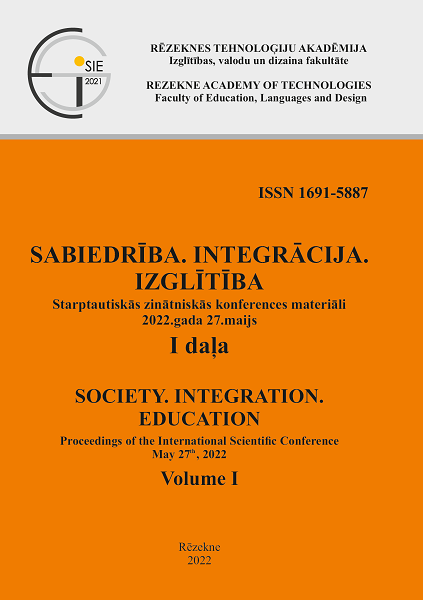ICT SCAFFOLDING FOR SCHOOL EDUCATION IN COVID-19 LOCKDOWN
DOI:
https://doi.org/10.17770/sie2022vol1.6873Keywords:
ICT for scaffolding, new educational technologies, school education during COVID-19 breakout, students’ inclusionAbstract
The COVID-19 situation, where the educational process had to be as flexible as possible, revealed that the use of information and communication technologies (ICT) has become a challenge for Lithuanian schools. In early 2021, we conducted focus group discussions in four Lithuanian schools to investigate how educational technology can enable an inclusive educational process. The analysis of the key determinants of pedagogical success and schools’ decisions on the unified use of ICT to include all students in learning, the scaffolding of the educational process using ICT revealed the two main factors. These factors ensuring the scaffolding process are: (1) how teachers remove the learning barriers and support students by use of educational technologies; (2) what helps teachers to transfer responsibility to students and enables their participation in the educational process. When we examined the potential of ICT to engage students, we found several differences between schools, namely: technology provision, the teachers’ ICT skills, the experience of the school community itself, the readiness of the school, teachers, and students to teach and to learn by distance or blended learning applying new ICT-based educational scenarios. The study results showed that the gains made during the COVID-19 lockdown in Lithuania in combining teaching solutions with the use of technology can become the ‘new normal’ and can help schools address the issue of inclusion for all students.
References
Adipat, S. (2021). Developing Technological Pedagogical Content Knowledge (TPACK) through Technology-Enhanced Content and Language-Integrated Learning (T-CLIL) Instruction. Education and Information Technologies, 26(5), 6461-6477.
Belland, B.R. (2014). Scaffolding: Definition, current debates, and future directions. In Handbook of research on educational communications and technology (pp. 505-518). Springer, New York, NY.
Bitinas, B. (2013). Rinktiniai edukologiniai raštai. Vilnius: Edukologija.
Ersani, N.P.D., Suwastini, N.K.A., & Artini, L.P. (2021). Schemes of Scaffolding in Online Education. Retorika: Jurnal Ilmu Bahasa, 7(1), 10-18. DOI: https://doi.org/10.22225/jr.7.1.2941.10-18
Goodyear, P. (2020). Design and co-configuration for hybrid learning: Theorising the practices of learning space design. British Journal of Educational Technology, 51(4). Retrieved from https://www.researchgate.net/publication/339932178_Design_and_co-configuration_for_hybrid_learning_Theorising_the_practices_of_learning_space_design
Hsieh, H.F., & Shannon, S.E. (2005). Three approaches to qualitative content analysis. Qualitative health research, 15(9), 1277-1288.
Krueger, R.A., Casey, M.A., Donner, J., Kirsch, S., & Maack, J.N. (2001). Social analysis: selected tools and techniques. World Dev, 36.
Mishra, P., & Koehler, M.J. (2006). Technological pedagogical content knowledge: A framework for teacher knowledge. Teachers college record, 108(6), 1017-1054.
Suryani, Y., Ningrum, A.R., Hidayah, N., & Dewi, N.R. (2021, February). The effectiveness of blended learning-based scaffolding strategy assisted by google classroom toward the learning outcomes and students’ self-efficacy. In Journal of Physics: Conference Series. Vol. 1796, No. 1, p. 012031. IOP Publishing.
Vaughn, S., Schumm, J.S., & Sinagub, J.M. (1996). Focus group interviews in education and psychology. Sage.
Yu, Z. (2021). The effects of gender, educational level, and personality on online learning outcomes during the COVID-19 pandemic. International Journal of Educational Technology in Higher Education, 18(1), 1-17.






